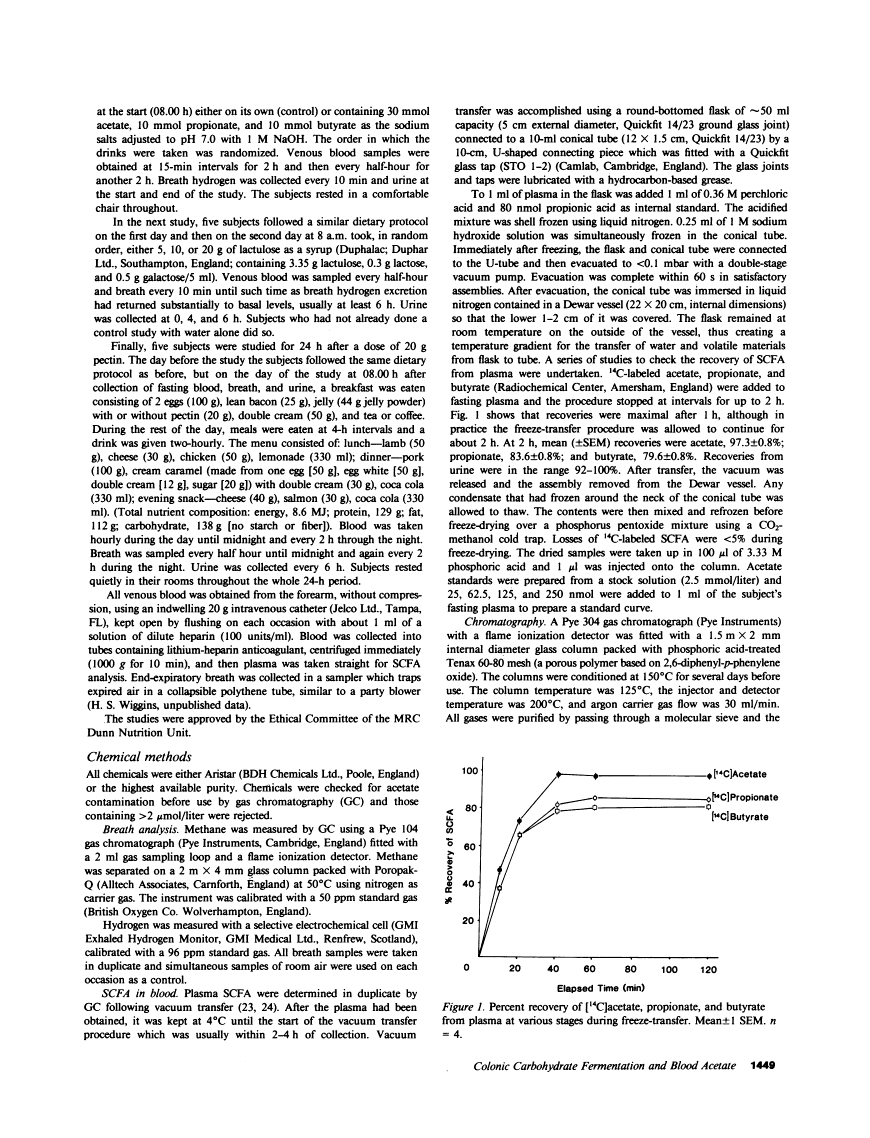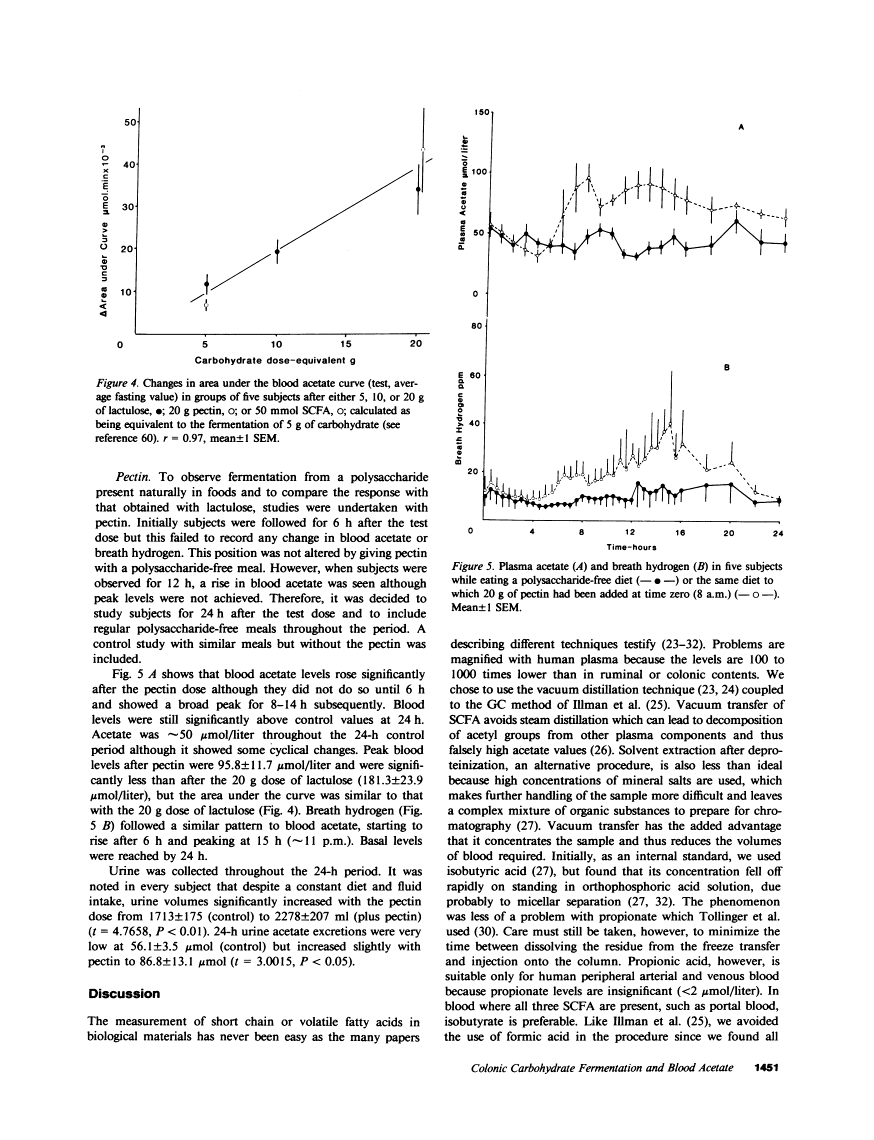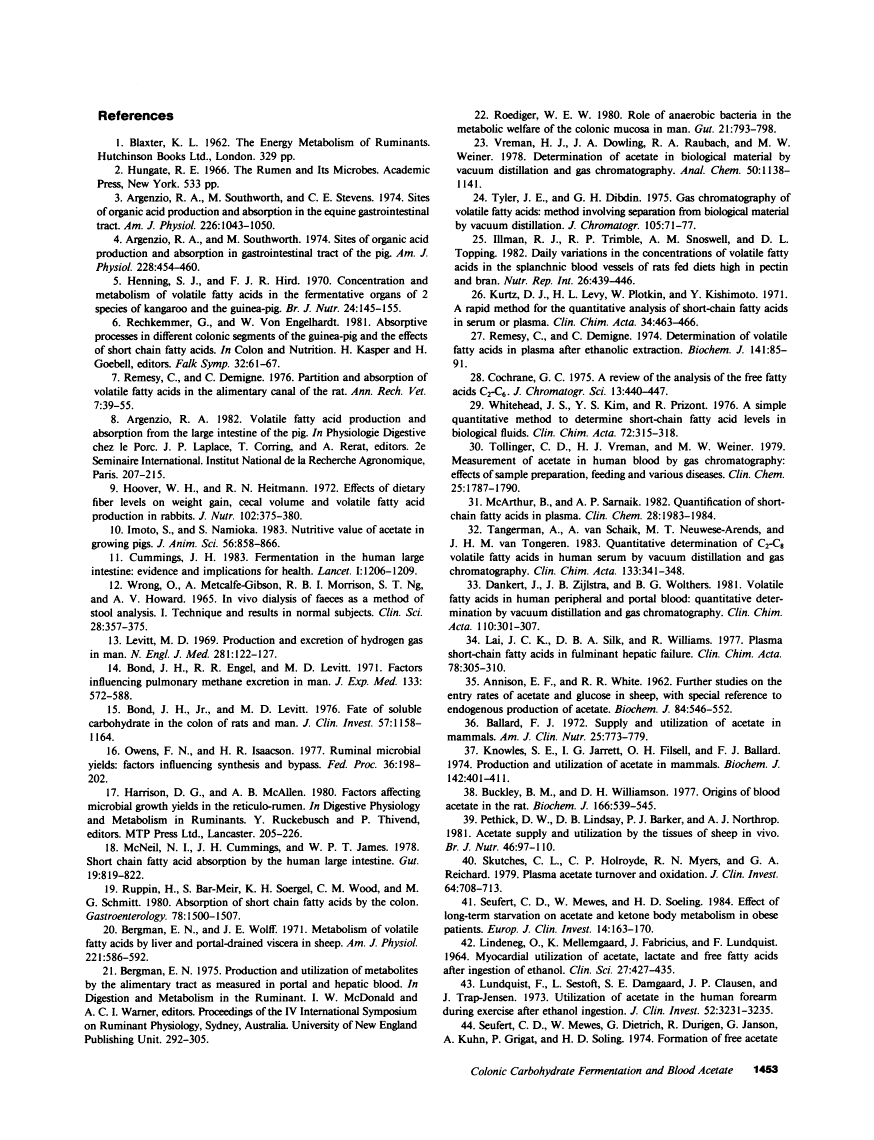Abstract
Free full text

Carbohydrate fermentation in the human colon and its relation to acetate concentrations in venous blood.
Abstract
There is now substantial evidence that some dietary polysaccharides, notably dietary fiber, escape absorption in the small bowel and are then broken down in the large intestine of man. The main end products of this colonic digestive process, which is anerobic, are short chain fatty acids (SCFA), and acetic, propionic, and butyric acids. Although these acids are known to be absorbed from the colon, their subsequent fate and significance is unknown. We have measured venous blood SCFA levels in healthy subjects after a 16-h fast, and then following oral doses of either 50 mmol SCFA, 5, 10, or 20 g doses of the fermentable carbohydrate lactulose, or 20 g of pectin. Fasting venous blood acetate was 53.8 +/- 4.4 mumol/liter (SEM) (n = 14). Fasting arterial blood acetate, taken simultaneously with venous blood in six subjects, was higher; 125.6 +/- 13.5 mumol/liter (arterial) vs. 61.1 +/- 6.9 mumol/liter (venous). Significant levels of propionate or butyrate were not detected in any blood samples. Following an oral dose of 50 mmol mixed SCFA, venous blood acetate reached a peak of 194.1 +/- 57.9 mumol/liter at 45 min and returned to fasting levels at 2 h. Blood acetate also rose in response to lactulose, peak levels occurring 2-4 h after the dose: 5 g, 98.6 +/- 23.1 mumol/liter; 10 g, 127.3 +/- 18.2 mumol/liter; and 20 g, 181.3 +/- 23.9 mumol/liter. Pectin fermentation was much slower, with blood acetate levels starting to rise after 6 h and remaining elevated at about twice fasting levels for the subsequent 18 h. However, areas under the blood acetate curves were closely related (r = 0.97; n = 5), whatever the source of acetate. These studies show that the large intestine makes an important contribution to blood acetate levels in man and that fermentation may influence metabolic processes well beyond the wall of this organ.
Full text
Full text is available as a scanned copy of the original print version. Get a printable copy (PDF file) of the complete article (1.3M), or click on a page image below to browse page by page. Links to PubMed are also available for Selected References.
Selected References
These references are in PubMed. This may not be the complete list of references from this article.
- Argenzio RA, Southworth M, Stevens CE. Sites of organic acid production and absorption in the equine gastrointestinal tract. Am J Physiol. 1974 May;226(5):1043–1050. [Abstract] [Google Scholar]
- Argenzio RA, Southworth M. Sites of organic acid production and absorption in gastrointestinal tract of the pig. Am J Physiol. 1975 Feb;228(2):454–460. [Abstract] [Google Scholar]
- Hennings SJ, Hird FJ. Concentrations and metabolism of volatile fatty acids in the fermentative organs of two species of kangaroo and the guinea-pig. Br J Nutr. 1970 Mar;24(1):145–155. [Abstract] [Google Scholar]
- Remesy C, Demigne C. Partition and absorption of valatile fatty acids in the alimentary canal of the rat. Ann Rech Vet. 1976;7(1):39–55. [Abstract] [Google Scholar]
- Hoover WH, Heitmann RN. Effects of dietary fiber levels on weight gain, cecal volume and volatile fatty acid production in rabbits. J Nutr. 1972 Mar;102(3):375–379. [Abstract] [Google Scholar]
- Imoto S, Namioka S. Nutritive value of acetate in growing pigs. J Anim Sci. 1983 Apr;56(4):858–866. [Abstract] [Google Scholar]
- Cummings JH. Fermentation in the human large intestine: evidence and implications for health. Lancet. 1983 May 28;1(8335):1206–1209. [Abstract] [Google Scholar]
- WRONG O, METCALFE-GIBSON A, MORRISON RB, NG ST, HOWARD AV. IN VIVO DIALYSIS OF FAECES AS A METHOD OF STOOL ANALYSIS. I. TECHNIQUE AND RESULTS IN NORMAL SUBJECTS. Clin Sci. 1965 Apr;28:357–375. [Abstract] [Google Scholar]
- Levitt MD. Production and excretion of hydrogen gas in man. N Engl J Med. 1969 Jul 17;281(3):122–127. [Abstract] [Google Scholar]
- Bond JH, Jr, Engel RR, Levitt MD. Factors influencing pulmonary methane excretion in man. An indirect method of studying the in situ metabolism of the methane-producing colonic bacteria. J Exp Med. 1971 Mar 1;133(3):572–588. [Europe PMC free article] [Abstract] [Google Scholar]
- Bond JH, Jr, Levitt MD. Fate of soluble carbohydrate in the colon of rats and man. J Clin Invest. 1976 May;57(5):1158–1164. [Europe PMC free article] [Abstract] [Google Scholar]
- Owens FN, Isaacson HR. Ruminal microbial yields: factors influencing synthesis and bypass. Fed Proc. 1977 Feb;36(2):198–202. [Abstract] [Google Scholar]
- McNeil NI, Cummings JH, James WP. Short chain fatty acid absorption by the human large intestine. Gut. 1978 Sep;19(9):819–822. [Europe PMC free article] [Abstract] [Google Scholar]
- Ruppin H, Bar-Meir S, Soergel KH, Wood CM, Schmitt MG., Jr Absorption of short-chain fatty acids by the colon. Gastroenterology. 1980 Jun;78(6):1500–1507. [Abstract] [Google Scholar]
- Bergman EN, Wolff JE. Metabolism of volatile fatty acids by liver and portal-drained viscera in sheep. Am J Physiol. 1971 Aug;221(2):586–592. [Abstract] [Google Scholar]
- Roediger WE. Role of anaerobic bacteria in the metabolic welfare of the colonic mucosa in man. Gut. 1980 Sep;21(9):793–798. [Europe PMC free article] [Abstract] [Google Scholar]
- Vreman HJ, Dowling JA, Raubach RA, Weiner MW. Determination of acetate in biological material by vacuum microdistillation and gas chromatography. Anal Chem. 1978 Jul;50(8):1138–1141. [Abstract] [Google Scholar]
- Tyler JE, Dibdin GH. Gas chromatography of volatile fatty acids. Method involving separation from biological material by vacuum distillation. J Chromatogr. 1975 Feb 19;105(1):71–77. [Abstract] [Google Scholar]
- Kurtz DJ, Levy HL, Plotkin W, Kishimoto Y. A rapid method for the quantitative analysis of short-chain fatty acids in serum or plasma. Clin Chim Acta. 1971 Oct;34(3):463–466. [Abstract] [Google Scholar]
- Remesy C, Demigne C. Determination of volatile fatty acids in plasma after ethanolic extraction. Biochem J. 1974 Jul;141(1):85–91. [Europe PMC free article] [Abstract] [Google Scholar]
- Cochran GC. A review of the analysis of free fatty acids [C2-C6]. J Chromatogr Sci. 1975 Sep;13(9):440–447. [Abstract] [Google Scholar]
- Whitehead JS, Kim YS, Prizont R. A simple quantitative method to determine short chain fatty acid levels in biological fluids. Clin Chim Acta. 1976 Nov 1;72(3):315–318. [Abstract] [Google Scholar]
- Tollinger CD, Vreman HJ, Weiner MW. Measurement of acetate in human blood by gas chromatography: effects of sample preparation, feeding, and various diseases. Clin Chem. 1979 Oct;25(10):1787–1790. [Abstract] [Google Scholar]
- McArthur B, Sarnaik AP. Quantification of short-chain fatty acids in plasma. Clin Chem. 1982 Sep;28(9):1983–1984. [Abstract] [Google Scholar]
- Tangerman A, van Schaik A, Meuwese-Arends MT, van Tongeren JH. Quantitative determination of C2-C8 volatile fatty acids in human serum by vacuum distillation and gas chromatography. Clin Chim Acta. 1983 Oct 14;133(3):341–348. [Abstract] [Google Scholar]
- Dankert J, Zijlstra JB, Wolthers BG. Volatile fatty acids in human peripheral and portal blood: quantitative determination vacuum distillation and gas chromatography. Clin Chim Acta. 1981 Mar 5;110(2-3):301–307. [Abstract] [Google Scholar]
- Lai JC, Silk DB, Williams R. Plasma short-chain fatty acids in fulminant hepatic failure. Clin Chim Acta. 1977 Jul 15;78(2):305–310. [Abstract] [Google Scholar]
- ANNISON EF, WHITE RR. Further studies on the entry rates of acetate and glucose in sheep, with special reference to endogenous production of acetate. Biochem J. 1962 Sep;84:546–552. [Europe PMC free article] [Abstract] [Google Scholar]
- Ballard FJ. Supply and utilization of acetate in mammals. Am J Clin Nutr. 1972 Aug;25(8):773–779. [Abstract] [Google Scholar]
- Knowles SE, Jarrett IG, Filsell OH, Ballard FJ. Production and utilization of acetate in mammals. Biochem J. 1974 Aug;142(2):401–411. [Europe PMC free article] [Abstract] [Google Scholar]
- Buckley BM, Williamson DH. Origins of blood acetate in the rat. Biochem J. 1977 Sep 15;166(3):539–545. [Europe PMC free article] [Abstract] [Google Scholar]
- Pethick DW, Lindsay DB, Barker PJ, Northrop AJ. Acetate supply and utilization by the tissues of sheep in vivo. Br J Nutr. 1981 Jul;46(1):97–110. [Abstract] [Google Scholar]
- Skutches CL, Holroyde CP, Myers RN, Paul P, Reichard GA. Plasma acetate turnover and oxidation. J Clin Invest. 1979 Sep;64(3):708–713. [Europe PMC free article] [Abstract] [Google Scholar]
- Seufert CD, Mewes W, Soeling HD. Effect of long-term starvation on acetate and ketone body metabolism in obese patients. Eur J Clin Invest. 1984 Apr;14(2):163–170. [Abstract] [Google Scholar]
- LINDENEG O, MELLEMGAARD K, FABRICIUS J, LUNDQUIST F. MYOCARDIAL UTILIZATION OF ACETATE, LACTATE AND FREE FATTY ACIDS AFTER INGESTION OF ETHANOL. Clin Sci. 1964 Dec;27:427–435. [Abstract] [Google Scholar]
- Lundquist F, Sestoft L, Damgaard SE, Clausen JP, Trap-Jensen J. Utilization of acetate in the human forearm during exercise after ethanol ingestion. J Clin Invest. 1973 Dec;52(12):3231–3235. [Europe PMC free article] [Abstract] [Google Scholar]
- Cummings JH. Short chain fatty acids in the human colon. Gut. 1981 Sep;22(9):763–779. [Europe PMC free article] [Abstract] [Google Scholar]
- Stevens CE, Stettler BK. Transport of fatty acid mixtures across rumen epithelium. Am J Physiol. 1966 Jul;211(1):264–271. [Abstract] [Google Scholar]
- Roediger WE. The colonic epithelium in ulcerative colitis: an energy-deficiency disease? Lancet. 1980 Oct 4;2(8197):712–715. [Abstract] [Google Scholar]
- Roediger WE. Utilization of nutrients by isolated epithelial cells of the rat colon. Gastroenterology. 1982 Aug;83(2):424–429. [Abstract] [Google Scholar]
- Rémésy C, Demigné C, Chartier F. Origin and utilization of volatile fatty acids in the rat. Reprod Nutr Dev. 1980;20(4B):1339–1349. [Abstract] [Google Scholar]
- Sallee VL, Dietschy JM. Determinants of intestinal mucosal uptake of short- and medium-chain fatty acids and alcohols. J Lipid Res. 1973 Jul;14(4):475–484. [Abstract] [Google Scholar]
- Argenzio RA, Whipp SC. Inter-relationship of sodium, chloride, bicarbonate and acetate transport by the colon of the pig. J Physiol. 1979 Oct;295:365–381. [Abstract] [Google Scholar]
- Saunders DR, Wiggins HS. Conservation of mannitol, lactulose, and raffinose by the human colon. Am J Physiol. 1981 Nov;241(5):G397–G402. [Abstract] [Google Scholar]
- Bond JH, Jr, Levitt MD, Prentiss R. Investigation of small bowel transit time in man utilizing pulmonary hydrogen (H2) measurements. J Lab Clin Med. 1975 Apr;85(4):546–555. [Abstract] [Google Scholar]
- La Brooy SJ, Male PJ, Beavis AK, Misiewicz JJ. Assessment of the reproducibility of the lactulose H2 breath test as a measure of mouth to caecum transit time. Gut. 1983 Oct;24(10):893–896. [Europe PMC free article] [Abstract] [Google Scholar]
- Cummings JH, Southgate DA, Branch WJ, Wiggins HS, Houston H, Jenkins DJ, Jivraj T, Hill MJ. The digestion of pectin in the human gut and its effect on calcium absorption and large bowel function. Br J Nutr. 1979 May;41(3):477–485. [Abstract] [Google Scholar]
- Sandberg AS, Ahderinne R, Andersson H, Hallgren B, Hultén L. The effect of citrus pectin on the absorption of nutrients in the small intestine. Hum Nutr Clin Nutr. 1983 May;37(3):171–183. [Abstract] [Google Scholar]
- Jenkins DJ, Thorne MJ, Camelon K, Jenkins A, Rao AV, Taylor RH, Thompson LU, Kalmusky J, Reichert R, Francis T. Effect of processing on digestibility and the blood glucose response: a study of lentils. Am J Clin Nutr. 1982 Dec;36(6):1093–1101. [Abstract] [Google Scholar]
- Anderson IH, Levine AS, Levitt MD. Incomplete absorption of the carbohydrate in all-purpose wheat flour. N Engl J Med. 1981 Apr 9;304(15):891–892. [Abstract] [Google Scholar]
Associated Data
Articles from The Journal of Clinical Investigation are provided here courtesy of American Society for Clinical Investigation
Full text links
Read article at publisher's site: https://doi.org/10.1172/jci111847
Read article for free, from open access legal sources, via Unpaywall:
http://www.jci.org/articles/view/111847/files/pdf
Citations & impact
Impact metrics
Article citations
Delving the depths of 'terra incognita' in the human intestine - the small intestinal microbiota.
Nat Rev Gastroenterol Hepatol, 23 Oct 2024
Cited by: 0 articles | PMID: 39443711
Review
Effects of the gut microbiota and its metabolite short-chain fatty acids on endometriosis.
Front Cell Infect Microbiol, 14:1373004, 13 Jun 2024
Cited by: 0 articles | PMID: 38938880
Review
Response to letter-to-the-editor: "Acetyl-CoA synthetase (ACSS2) does not generate butyryl- and crotonyl-CoA".
Mol Metab, 83:101920, 19 Mar 2024
Cited by: 0 articles | PMID: 38513933 | PMCID: PMC11082060
Gut microbial metabolites SCFAs and chronic kidney disease.
J Transl Med, 22(1):172, 18 Feb 2024
Cited by: 3 articles | PMID: 38369469 | PMCID: PMC10874542
Review Free full text in Europe PMC
Bacterial acetate metabolism and its influence on human epithelia.
Emerg Top Life Sci, 8(1):1-13, 01 Feb 2024
Cited by: 6 articles | PMID: 36945843 | PMCID: PMC10903459
Review Free full text in Europe PMC
Go to all (191) article citations
Similar Articles
To arrive at the top five similar articles we use a word-weighted algorithm to compare words from the Title and Abstract of each citation.
The contribution of the large intestine to blood acetate in man.
Clin Sci (Lond), 80(2):177-182, 01 Feb 1991
Cited by: 50 articles | PMID: 1848171
Fecal short-chain fatty acids in patients with diarrhea-predominant irritable bowel syndrome: in vitro studies of carbohydrate fermentation.
J Pediatr Gastroenterol Nutr, 23(3):280-286, 01 Oct 1996
Cited by: 90 articles | PMID: 8890079
Quantification of in Vivo Colonic Short Chain Fatty Acid Production from Inulin.
Nutrients, 7(11):8916-8929, 28 Oct 2015
Cited by: 78 articles | PMID: 26516911 | PMCID: PMC4663568
Colonic health: fermentation and short chain fatty acids.
J Clin Gastroenterol, 40(3):235-243, 01 Mar 2006
Cited by: 1258 articles | PMID: 16633129
Review












